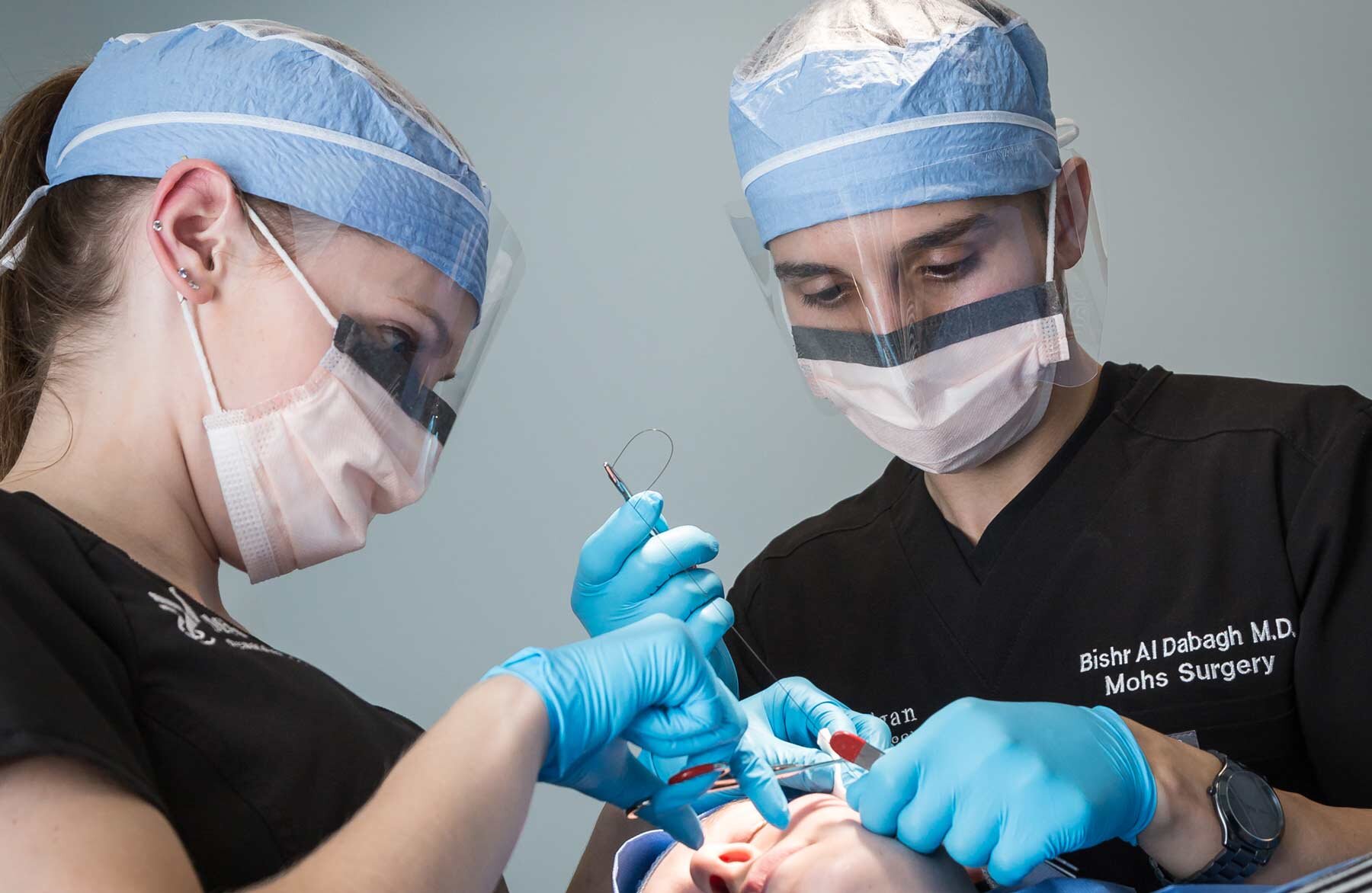
Mohs Surgery
Mohs Micrographic Surgery is the gold standard in skin cancer treament
Most Precise
Examines 100% of tumor margin
Spares healthy tissue
Highest Cure Rate
Up to 99% for primary tumors
Up to 94% for recurrent tumors
Cost-Effective
Single outpatient surgery
Includes pathology & wound care
Patient-Centered
Single visit in office setting
Local anesthesia
Precise Outcome
Leaves smallest defect
Maximizes aesthetic result
What is Mohs Micrographic Surgery?
Developed by Dr. Frederick Mohs, Mohs micrographic surgery is a specialized, highly effective technique focusing on the accurate removal of skin cancer. It allows the best tracking of the skin cancer (by visualizing 100% of the surgical margins), while sparing the greatest amount of surrounding healthy tissue.
Mohs surgery provides the highest cure rates (up to 99%) for basal cell and squamous cell carcinomas when compared to any other method. The surgeon then performs reconstruction of the defect. There is no need to go to a surgical center or hospital, and the patient can go home the same day.
There is no need for general anesthesia, preventing a lengthy recovery and reducing surgical complication and risk. Anesthesia is injected directly into the surrounding area and maintained for the duration of your procedure. Mohs surgery is recommended for recurrent skin cancers or skin cancers where maximum preservation of healthy tissue is vital, such as the face, hands, feet, and genitals.
The Mohs Surgery Process
The roots of a skin caner may extend beyond the visible portion of the tumor. If these roots are not removed the cancer will recur.
1/ Local anesthesia is injected to numb the area completely, and the visible portion of the tumor is removed.
2/ The first layer of tissue with a narrow margin around the tumor is surgically removed. The wound is bandaged temporarily while lab work begins.
3/ The surgeon cuts the tissue into sections, color codes them with dyes and draws a map of the surgical site. In the lab, the divided tissue is frozen and very thin horizontal slices are cut, placed on microscope slides and stained for examination.
4/ The undersurface and edges of each tissue section are examined under a microscope by the surgeon for evidence of remaining cancer.
5/ If cancer cells are found under the microscope the surgeon marks there location on the "map" and returns to the patient to remove another layer of skin- but only from precisely where the cancer cells remain. This process is repeated until there is no evidence of cancer remaining.
6/ The wound may be left open to heal or closed with stitches, depending on its size and location. In most cases the surgeon will repair the wound immediately after obtaining clear margins. In some cases, the wound will need reconstruction with a skin flap where neighboring tissue is moved into the wound or possibly a skin graft. In some cases, your Mohs surgeon may coordinate repair with another specialist.
© American College of Mohs Surgery 2017- All Rights Reserved
What Skin Cancer Qualifies For Mohs Surgery?
Mohs surgery is indicated for high risk skin cancers with the following features:
High risk location (such as head, neck, hands, feet, genitalia) where preserving cosmetic appearance and function are essential
Large tumors (>1cm on head, >2cm on trunk)
Recurrent skin cancers that have been previously treated
Poorly defined margins
Located in scars, burns, or previous sites of radiation therapy
High risk tumors that are painful, rapidly growing, or invading nerves
Aggressive histologic (microscopic) patterns
Incompletely excised tumors
Skin cancer in immunosuppressed patients (cancer or organ transplant patients)
See the American College of Mohs Surgery, the American Academy of Dermatology, or American Academy of Family Physicians for more information.
Post Operative Care
The surgeon will determine the optimal option for wound healing, which include:
Allowing wound to heal naturally without the use of sutures or follow-up surgeries.
Repairing the wound with sutures. Sometimes, skin grafts or flaps from other areas may be used for larger wounds.
Referring to another reconstructive surgeon depending on the size, depth and location.
Risks:
Even with the highest cure rate (up to 99%), there is still a possibility of recurrence with Mohs surgery.
Scarring, bleeding, infection, nerve injury, or medication side-effects.
Please ask our office for the Mohs Surgery Consent form for the full list of risks.
Prior to discharge, our medical assistants will advise you on appropriate wound care. They will also provide you with instructions and a direct phone number to reach the surgeon. Our staff will schedule a follow-up appointment to remove sutures within 1-2 weeks after surgery. We often see our patients back within a month or so for a post-operative wound check to ensure the healing process is going well.
Mohs Surgery by the numbers
1 Price
Thanks to Mohs surgery high sucess rates, most patients only require a single surgery- far less costly than other methods, which can require multiple surgeries and multiple fees.
1 Day
Although Mohs surgery is an outpatient procedure, the process can last several hours, depending on the extent of your condition. Play it safe and clear your schedule on surgery day.
High Cure Rates
Mohs surgery has a cure rate of up to 99% for primary tumors and up to 94% on recurrent tumors, but it is still important to keep up with regular skin checks and follow-up appointments after surgery.
1 Year
In some cases, it can take up to a year for your surgical site to fully heal. If you have a scar expect it to flatten significantly and fade in color during this time.
4 Reconstruction Options
There are 4 main options for reconstruction after Mohs surgery, ranging from letting incision heal on its own to (rare) reconstructive surgery. Your Mohs surgeon will help you determine what's best.
1 Organization
The American College of Mohs Surgery requires rigorous training as a condition of membership. By choosing a fellowship-trained Mohs surgeon, you're making the best desicion for your long term health.
Frequently Asked Questions
What does Mohs stand for?
Basal cell carcinoma (BCC) is the most common type of skin cancer and the most frequently occurring of all cancers. In the United States alone, approximately 4 million cases are diagnosed annually. BCCs arises from the epidermis and grow in an erratic and uncontrolled fashion. Because BCCs grows slowly, most are curable and cause minimal skin injury when diagnosed and treated early.
Will I need general anesthesia? Will I need to go to the hospital?
Mohs surgery is performed at our outpatient clinic in Mooresville. You will not need a lengthy hospital admission, nor will you undergo the risks associated with general anesthesia. Having successfully completed thousands of surgeries, Dr. Al-Dabagh and his staff are experienced at making your visit as pain-free and comfortable as possible.
What are my activity restrictions after surgery?
You should avoid exercise or participate in sports for two weeks following the surgery. During this time, you will be asked to limit all activities that increase your heart rate and not lift objects heavier than a gallon of milk. Click here for more information.
Can I travel after surgery?
We recommend trying to stay local for the first week for closer monitoring. If you must, then make sure you have access to medical care. Please inform us of travel arrangements so we can plan accordingly.
Can I shower after surgery? Can I swim or use a hot tub?
The wound must be kept dry for at least 48 hours, and maybe longer. You can then shower. However, please refrain from swimming or using hot tubs until the wound heals.
What do I do if my wound becomes red, has discharge or is foul smelling? What if I have a fever?
Please contact our office as soon as you can, at (704) 230-1302. If it is after hours, please call the surgeon’s direct cell phone.
Do I need to take time off work? Will I receive paperwork for time off?
Yes, you should take the day of your procedure off. If your work involves physical activity, you may be required to take more time off. Our staff will make sure you receive the proper paperwork before you leave.
How long will the procedure take?
The length of the procedure depends on the type of surgery and how many stages are necessary to clear the skin cancer. Plan on taking the entire day off.
Do I need a follow-up? Can I go on vacation during this time?
Yes, you will have a follow-up within 1-4 weeks. It is advised that you do not travel too far, in case something happens to your wound.
How long will it take for my wound to heal? Does it matter if I have diabetes?
Healing time will depend on the size of the wound, the location, and how well you take care of your wound after surgery. If you have diabetes, controlling your blood sugars will also improve wound healing. You will be given detailed wound instructions; it is very important that you follow these. DO NOT let your wound scab over.
How many procedures has Dr. Al-Dabagh done?
He has performed over 11,000 Mohs surgeries and many more excisions and other dermatologic surgeries.
Does my insurance cover this procedure? Will I have out-of-pocket expenses?
Surgery for skin cancer is medically necessary and therefore covered by almost all insurances. We will review your insurance plan and inform you if you have a copay or out of pocket cost. We also recommend you contact your insurance directly to confirm costs.
Can I eat before the procedure?
Yes, make sure you eat a good breakfast and are well-hydrated. Try to avoid coffee or other caffeinated beverages.
Should I take my daily medications?
Yes, take all your prescribed medications. Avoid taking Aspirin, Advil, Aleve, Naproxen, and Celebrex for 14 days before surgery, UNLESS prescribed by your primary doctor. Continue your Coumadin (warfarin), Eliquis, Xarelto, Lovenox, heparin, Pradaxa, or any other blood thinner. Avoid vitamins or homeopathic medications 7 days prior to surgery.
When can I resume medications?
If you stop any medications, you can resume them the day after surgery.
Learn more
Why Does My Cancer Need Mohs Surgery?” Mohs Surgery Patient Education by American College of Mohs Surgery. 2 March 2017. www.skincancermohssurgery.org/about-mohs-surgery/why-does-my-cancer-need-mohs-surgery .
Connolly, Suzanne M., et al. “AAD/ACMS/ASDSA/ASMS 2012 Appropriate Use Criteria for Mohs Micrographic Surgery: A Report of the American Academy of Dermatology, American College of Mohs Surgery, American Society for Dermatologic Surgery Association, and the American Society for Mohs Surgery.” Journal of the American Academy of Dermatology. October 2012. Volume 67, Issue 4. pp. 531–550. doi:10.1016/j.jaad.2012.06.009.
Bowen, Glen M., et al. “Mohs Micrographic Surgery.” American Family Physician. American Academy of Family Physicians. 1 Sept. 2005. https://www.aafp.org/afp/2005/0901/p845.html.
What is Mohs Surgery? American College of Mohs Surgery https://www.mohscollege.org/for-patients
What is Mohs Surgery? American Academy of Dermatology Association https://www.aad.org/public/diseases/skin-cancer/types/common/melanoma/mohs-surgery


















